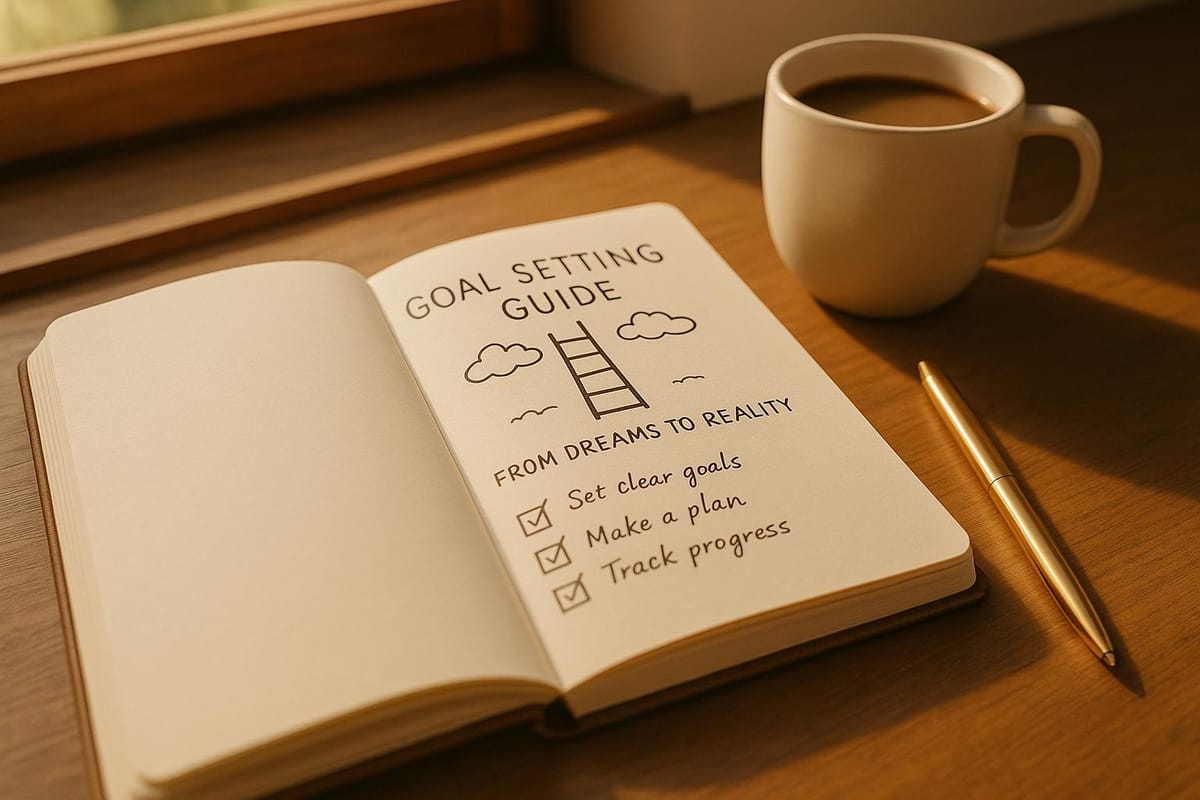Goal Setting Guide: From Dreams to Reality
Transform your aspirations into achievements with effective goal-setting strategies, visualization techniques, and tools to track progress.

Turning dreams into reality starts with action. Most people fail to achieve their aspirations because they lack clear, actionable goals. This guide focuses on bridging that gap by outlining proven strategies for goal setting and achievement. Here's what you'll learn:
- Set SMART goals: Specific, Measurable, Achievable, Relevant, and Time-bound goals give you clarity and direction.
- Visualize success: Use techniques like mental rehearsal, vision boards, and affirmations to stay motivated.
- Prioritize effectively: Tools like the Eisenhower Matrix help focus on what matters most.
- Track progress: Apps like Notion, Trello, and ClickUp simplify goal tracking.
- Build habits: Small, consistent actions lead to long-term success.
- Overcome setbacks: Treat challenges as learning opportunities and adjust your approach.
Success comes from consistent effort, not luck. Start small, track your progress, and stay disciplined. Your goals are within reach - take the first step today.
Goal Setting Workshop: How To Set Goals Effectively (Step-By-Step Guide)
Step 1: How to Create SMART Goals
The SMART framework is a powerful tool that turns vague aspirations into clear, actionable objectives. By ensuring your goals are Specific, Measurable, Achievable, Relevant, and Time-bound, this method provides a structured plan to guide your daily actions and long-term efforts.
What SMART Goals Are
Each element of the SMART framework works together to eliminate uncertainty and provide clear direction:
- Specific: Goals should answer the five "W" questions - who, what, where, when, and why - so there’s no room for ambiguity.
- Measurable: Include metrics that allow you to track progress. Ask questions like "How much?" or "How many?" to quantify success.
- Achievable: Set goals that are realistic given your resources and abilities.
- Relevant: Ensure your goals align with your broader objectives and priorities.
- Time-bound: Assign a deadline to create urgency and accountability.
This approach not only clarifies what success looks like but also makes it easier to track progress and address any missed milestones.
SMART Goal Example
To see the SMART framework in action, consider how business leaders apply it to achieve tangible results.
Ritchie Tendencia, CEO of CSV Now, focused on improving employee satisfaction and performance. Instead of a vague goal like "make employees happier", he created this SMART goal:
"I want to reduce employee turnover rates by at least 10 percent in the next quarter." [2]
This goal meets all SMART criteria: it’s specific (reduce turnover), measurable (by 10 percent), achievable, relevant (boosting employee satisfaction), and time-bound (within a quarter). The result? A 15 percent reduction in turnover rates and increased client satisfaction [2].
Similarly, Axel Lavergne, Founder of ReviewFlowz, tackled customer retention with this SMART goal:
"We aim to reduce customer churn rate by 10 percent in six months." [2]
His team reached this goal by improving their onboarding process, offering better training resources, and maintaining regular communication with new customers [2].
On a personal level, Jake Munday of Custom Neon set a SMART goal for self-improvement:
"I want to complete a leadership development course in three months, by dedicating two hours every week to study." [2]
By clearly defining the timeframe, action, and outcome, he stayed on track and achieved his goal.
Mistakes to Avoid When Setting Goals
Even with a solid framework like SMART, there are common pitfalls that can hinder progress:
- Lack of Clarity: Goals like "get healthier" or "make more money" are too vague to provide direction. Instead, focus on specifics, such as "exercise three times a week" or "increase monthly income by 20%."
- Overlooking Measurability: Without clear metrics, it’s hard to track progress. For instance, instead of saying "improve customer satisfaction", aim for a specific target like achieving a 90% satisfaction score [2].
- Setting Unrealistic Goals: Ambition is great, but goals should match your current resources and capabilities. As Jake Munday advises:
"Your goal should be challenging yet attainable with the available resources." [2]
- Ignoring Relevance: Goals should align with your broader objectives. Alex Ugarte, Operations Manager at London Office Space, stresses:
"Ensure [your goals] align closely with broader ambitions. This ensures that every effort directly supports your overarching aims, optimizing impact and resource use." [2]
- Skipping Deadlines: Without a timeline, goals lose urgency. Deadlines create accountability and keep you focused. Logan Mallory, VP of Marketing at Motivosity, adds:
"I always make sure I've got a few sessions scheduled across a week or two to revisit my SMART goals before finalizing them. SMART goals are like any rough draft. The very first stab at it probably won't be the best or most elegant. Give yourself time to play around with the goals, revisiting their clarity and details and really leaving space for final tweaks." [2]
Step 2: How to Visualize Success and Set Priorities
After setting your SMART goals, the next step is to bring them to life through visualization and prioritization. Visualization keeps you motivated by creating a vivid mental image of success, while prioritization ensures your energy is directed toward what truly matters. Below, we’ll explore practical ways to visualize success, prioritize effectively, and break large goals into smaller, actionable steps.
Visualization Techniques That Deliver Results
Visualization is all about forming a clear mental picture of your desired future. Research shows that imagining an experience can activate the same brain regions as actually living it, which can significantly improve performance.
Mental Rehearsal is a powerful way to prepare. This technique involves picturing yourself completing tasks flawlessly. Olympic skier Lindsey Vonn famously used this method:
"I always visualize the run before I do it. By the time I get to the start gate, I've run that race 100 times in my head… Once I visualize a course, I never forget it".
This practice not only sharpens focus but also reduces stress and boosts confidence.
Vision Boards are another effective tool. By creating a board filled with images and words that represent your goals, you create a daily visual reminder of what you’re working toward. Whether it’s a physical board or a digital one, place it somewhere you’ll see it often to keep your goals top of mind.
Affirmations help reinforce your goals with positive, present-tense statements. Instead of saying, "I will get fit", say, "I am strong and full of energy." Write these affirmations on cards and read them aloud daily to internalize them.
Sensory Triggers can anchor your visualizations to specific sensory experiences. For instance, listening to a particular song or using a favorite scent during visualization sessions can help you associate those sensations with your goals.
It’s important to visualize not just the outcome but the process. Research shows that students who imagined themselves studying effectively performed better than those who only visualized achieving a high grade. This dual focus prepares you for the effort required to succeed.
Setting Priorities to Stay Focused
With multiple goals vying for your attention, prioritization is key. Former President Dwight D. Eisenhower’s approach to managing tasks is a timeless strategy:
"I have two kinds of problems, the urgent and the important. The urgent are not important, and the important are never urgent."
This philosophy inspired the Eisenhower Matrix, which organizes tasks into four categories:
- Do immediately (urgent and important)
- Schedule for later (important but not urgent)
- Delegate (urgent but not important)
- Eliminate (neither urgent nor important).
Another method, the ABCDE Method, ranks tasks by importance:
- A-level tasks are critical and must be completed.
- B-level tasks are important but less urgent.
- C-level tasks are optional with no major consequences.
- D-level tasks should be delegated.
- E-level tasks should be removed entirely.
For daily prioritization, try the 1-3-9 Technique: focus on one high-priority task, three medium-priority tasks, and nine smaller tasks. For example, in a website redesign project, you might finalize wireframe approvals (high-priority), review sprint progress and update timelines (medium-priority), and handle smaller tasks like organizing files or responding to emails (low-priority).
Finally, the Pareto Principle (80/20 Rule) reminds us that 20% of efforts often produce 80% of results. Identify the tasks that fall into this critical 20% and channel your energy there.
As Stephen Covey famously said:
"The key is not to prioritize what's on your schedule, but to schedule your priorities."
Breaking Big Goals into Manageable Steps
Big goals can feel overwhelming, but breaking them into smaller steps makes them achievable. This approach ensures consistent progress and keeps you on track.
Start by defining your ultimate goal using the SMART framework. Then, identify key milestones along the way. For each milestone, create smaller, actionable tasks. Organize these tasks in order of priority and sequence, and set a timeline for completion.
For example, if your goal is to start a business, your milestones might include conducting market research, developing your product, creating a marketing plan, and launching. Each milestone can be broken down further into smaller tasks, like identifying your target audience, designing a prototype, or drafting ad copy.
Regularly track your progress and celebrate small wins. Set aside time to review your plans, address obstacles, and make adjustments as needed. Anticipate challenges and create "if-then" plans to stay prepared. For instance, "If I feel overwhelmed, then I will delegate lower-priority tasks or adjust my deadlines."
One entrepreneur coach shared the story of a client who felt overwhelmed by her business growth goals. By breaking her vision into manageable steps, she was able to grow revenue, reduce working hours, and improve her work-life balance - all within a few months. The secret? A clear, simple strategy paired with consistent action.
Step 3: Best Tools and Resources for Tracking Goals
After visualizing your goals and setting priorities, the next step is finding the right tools to monitor your progress. Digital tools can provide real-time updates, helping you stay focused, measure achievements, and maintain motivation.
Apps for Tracking Your Goals
The right apps can make all the difference in staying on track. These tools help break down big goals into actionable steps, celebrate milestones, and keep you consistent in monitoring progress.
Notion is a standout option for those who need more than just task management. As one of the top-rated tools on G2, it offers robust customization options, making it ideal for complex goal tracking and documentation.
Trello simplifies task management with its intuitive Kanban-style boards. Visual thinkers often find this tool especially helpful, and it boasts an impressive 4.5/5 rating on Capterra.
ClickUp is a versatile platform packed with features and customization options, catering to both individuals and teams. With a G2 rating of 4.7/5 from over 9,700 reviews and a Capterra rating of 4.6/5 from more than 4,000 reviews, it’s a favorite among users. Darya Krakovyak, Communications Lead at HYPERVSN, highlights its impact:
"ClickUp Goals help keep the focus of each and every department's member on what's really important, which is critical when the new product is being launched."
For habit tracking, Coach.me offers a free habit tracker with optional coaching starting at $100/month. Habitica turns tracking into a game and is completely free. Todoist combines task management with goal tracking and offers both a free plan and Pro features for $5/month.
| App | Best For | Pricing | Key Strength |
|---|---|---|---|
| Notion | Complex documentation | Free; Plus $10/month | All-in-one workspace |
| Trello | Visual task management | Free; Standard $5/month | Kanban simplicity |
| ClickUp | Versatile project management | Free; Paid from $7/month | Extensive customization |
| Todoist | Task and goal tracking | Free; Pro $5/month | Clean and simple interface |
| Coach.me | Habit tracking with coaching | Free tracker; $100/month | Professional support |
Books That Support Long-Term Success
While apps handle the mechanics of tracking, books offer deeper insights into achieving sustainable success. One standout is "Atomic Habits" by James Clear, a global bestseller with over 25 million copies sold and translations into more than 60 languages. It emphasizes how small, consistent improvements - just 1% better each day - can lead to extraordinary results.
"You do not rise to the level of your goals. You fall to the level of your systems."
- James Clear
Mark Manson, author of "The Subtle Art of Not Giving a F*ck", praises the book’s practicality:
"A supremely practical and useful book. James Clear distills the most fundamental information about habit formation, so you can accomplish more by focusing on less."
How to Choose the Right Tools for You
Choosing the right tools depends on your specific needs. Are you focused on personal growth, habit building, time management, or project management? For instance, a simple habit tracker like Habitica might work for personal habits, while more complex goals could benefit from platforms like ClickUp or Notion.
Key features to consider include customization, automation, progress tracking, and integration. If you prefer visual organization, tools like Trello offer clarity with their board layouts, while Notion provides detailed databases for deeper tracking.
Budget and team size also matter. Many tools offer free plans with robust functionality. For team-oriented solutions, Asana is great for small to mid-sized teams, ClickUp excels with its flexibility, and Wrike offers advanced options like resource management for larger organizations. Platforms like Monday.com and Smartsheet combine user-friendly interfaces with advanced organizational features.
Experts agree that effective tools do more than track metrics - they create systems that drive accountability and momentum. Jensen Savage, founder of Savage Growth Partners, puts it this way:
"Goal setting software is a place to create clarity, accountability and momentum by connecting daily tasks to long-term outcomes."
Brittany L. Truszkowski, COO at Grand Canyon Law Group, adds:
"What really matters is what that kind of visibility creates... Accountability, yes, but also recognition. And here's the broader takeaway for any business: goal-tracking software isn't just about holding people to metrics - it's about helping people see their progress and own it. When used well, it's a culture builder and a retention tool."
Combining the right apps with insights from books like "Atomic Habits" can help you build a system that ties every step - from goal-setting to accountability - together. By tailoring your tools to your needs, you can create a system that supports sustainable and meaningful progress.
Step 4: How to Stay Consistent and Handle Problems
Setting clear goals and tracking progress is crucial, but the real challenge lies in staying consistent. Even with the best tools and strategies, the difference between success and giving up often depends on how you handle the inevitable obstacles that come your way.
How to Build Consistent Habits
Consistency is the backbone of achieving long-term goals. Studies show that tracking progress significantly increases the likelihood of improvement. For instance, one study revealed that individuals who kept a daily food log lost twice as much weight as those who didn’t.
The secret to staying consistent? Start small. Focus on manageable, daily actions rather than overwhelming yourself with intensity. Tracking your progress right away creates a direct link between your efforts and results, which helps reinforce the habit. Over time, this positive feedback loop makes the behavior stick.
It’s important to remember that forming a new habit typically takes about 66 days. Patience is key. A simple rule to follow is: if you miss a day, get back on track immediately. Missing one day is just a slip; missing two can lead to a downward spiral. As James Clear wisely states:
"Missing once is an accident. Missing twice is the start of a new habit."
Celebrating small victories along the way can also keep you motivated.
How to Deal with Setbacks
Even with strong habits in place, setbacks are inevitable. They’re a natural part of any meaningful journey. When they happen, don’t ignore them - acknowledge the situation, allow yourself to process it emotionally, and then move forward. Remember, success often comes with a few stumbles along the way.
Instead of seeing setbacks as failures, treat them as opportunities to learn and adjust. For example, if you miss a workout or fall short of your goals for a week, don’t view it as proof of failure. Instead, analyze what went wrong. Was the goal too ambitious? Did you lack support? Were there external challenges? Use this insight to refine your approach. Adjust your goals to be more realistic and break them into smaller, more achievable steps.
If your current plan isn’t working, don’t hesitate to revise it. Sometimes, starting fresh with a new plan is the most effective way forward. Reconnect with your original motivation by reminding yourself why you started. Focusing on small wins - like feeling more energized, sleeping better, or boosting your confidence - can keep you moving forward.
These strategies, paired with consistent habits, create a solid foundation for long-term success.
Why Community and Support Matter
While personal resilience is essential, having a strong support system can make all the difference. Research shows that people with a reliable network are much more likely to reach their goals. Social support, accountability, and being part of a community can help you establish and maintain new habits.
Consider involving a friend, family member, or accountability partner who shares your goals. Regular check-ins with someone you trust can reignite your motivation when it starts to fade. Joining a community - whether it’s an online forum, a local group, or another shared space - can also provide encouragement. Being surrounded by like-minded individuals normalizes struggles and amplifies the joy of success.
Create a system of accountability to keep yourself on track. This could include weekly check-ins, mastermind groups, or online communities where members share progress and challenges. Knowing that others are rooting for you can make even the toughest days feel more manageable.
At FromZeroToGrow, we strive to provide this type of supportive environment. Our community is a space where members can share their journeys, learn from one another, and find partners who understand the ups and downs of turning goals into reality.
Conclusion: How to Close the Gap Between Dreams and Reality
Turning your dreams into reality isn't about luck - it's about having a plan and sticking to it. By using strategies like SMART goals, visualization, prioritization, and building habits, you can create a system that turns ideas into accomplishments.
Main Points to Keep in Mind
Achieving your goals comes down to four key elements:
- SMART goals: Clearly define what you want to achieve and set deadlines to keep yourself on track.
- Visualization: Picture your success to build confidence and stay motivated.
- Prioritization: Focus on what truly matters. Identify your values and rank your goals so you're working on things that make a real impact.
- Habit building: Create routines that make progress automatic. Tie new habits to things you already do and track your efforts to reinforce them.
Discipline is the real game-changer here. Motivation might get you started, but discipline is what keeps you moving forward when the initial excitement fades. As Marie Forleo wisely says:
"Success doesn't come from what you do occasionally, it comes from what you do consistently."
Taking Action
Bridging the gap between where you are and where you want to be starts with action. Here are some steps you can take right now to get started:
- Write down one major goal and break it into smaller, manageable steps for this week, this month, and beyond.
- Pick one or two simple habits that align with your goal and weave them into your daily routine. For instance, if your goal is better health, pair a 10-minute walk with your morning coffee. If you're learning a new skill, dedicate 15 minutes of practice during your evening downtime.
- Each morning, ask yourself: What’s one thing I can do today to move closer to my goal? This keeps you focused on progress, not perfection.
- Set up regular check-ins - weekly or monthly - to review your progress and make adjustments as needed.
- Track your progress in a way that works for you, whether it’s a journal, an app, or a calendar. Seeing those small wins pile up can be incredibly motivating.
The most important step? Start now. Every small action adds up, and consistency will take you further than you think.
Your dreams are waiting for you on the other side of consistent effort. The strategies in this guide are only as powerful as the action you take. So take that first step today and let momentum guide you toward the life you’ve envisioned.
FAQs
How can I use visualization to turn my goals into reality?
Visualization can be a game-changer when it comes to reaching your goals. By creating a detailed mental image of your success, you can sharpen your focus and ignite your motivation. Picture your desired outcome in as much detail as possible - what does it look like? How does it feel? Even consider the sounds around you. The more senses you engage, the more vivid and impactful your vision becomes.
Take it a step further by imagining the journey to your goal. Visualize the actions you'll take and how you'll overcome obstacles along the way. Tools like vision boards or setting aside time for daily visualization can help reinforce your commitment and keep your goals front and center. With consistent practice, you'll deepen your emotional connection to your aspirations and stay aligned with the path to achieving them.
What are the most common mistakes people make when setting SMART goals?
When creating SMART goals, one mistake people often make is being too vague. Goals need to be specific so they offer clear guidance and direction. Another common error is aiming too high with overly ambitious or unrealistic goals, which can end up causing frustration or even burnout. Additionally, neglecting to make goals measurable and time-bound can make it hard to monitor progress or hold yourself accountable.
To steer clear of these issues, focus on setting goals that are clear, realistic, and fit within your resources and timeline. The SMART framework works best when each part - Specific, Measurable, Achievable, Relevant, and Time-bound - is applied with care and thought.
How can I stay consistent with my habits when setbacks happen?
Consistency isn't about getting everything right all the time - it's about moving forward, one step at a time. Setbacks? They're part of the process. Instead of letting them derail you, plan for them. Revisit the reasons you started in the first place, and focus on taking small, manageable steps to regain momentum.
Try adopting a growth mindset. Think of challenges as chances to learn and grow rather than obstacles. Celebrate your wins, no matter how small - they’ll keep your motivation alive. Using tools like journals or apps to track your progress can also keep you accountable and on course. Remember, resilience fuels consistency, and every little step adds up!





